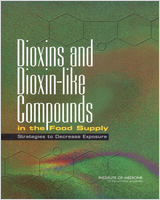NCBI Bookshelf. A service of the National Library of Medicine, National Institutes of Health.
Institute of Medicine (US) Committee on the Implications of Dioxin in the Food Supply. Dioxins and Dioxin-like Compounds in the Food Supply: Strategies to Decrease Exposure. Washington (DC): National Academies Press (US); 2003.

Dioxins and Dioxin-like Compounds in the Food Supply: Strategies to Decrease Exposure.
Show details- Aerobic
Growing, living, or occurring in the presence of molecular oxygen; for example, bacteria that require oxygen to survive.
- Anaerobic
Growing, living, or occurring in the absence of molecular oxygen.
- Beluga whale fat
Fat of the white whale, Delphinapterus leucas; the fat is commonly called blubber.
- Body burden
The total amount of a chemical, metal, or radioactive substance present at any time after absorption in the body of a human or animal.
- Brominated
Combined or saturated with bromine or any of its compounds.
- Carcinogen
An agent capable of initiating development of malignant tumors; may be a chemical, a form of electromagnetic radiation, or an inert solid body.
- Chlorinated
Any organic chemical that includes chlorine atoms; chlorinated organic compounds, along with other halogenated organics, have been implicated in health risks such as cancer, endocrine system disruption, birth defects, compromised immune systems, and reduced fertility.
- Congener
One of two or more compounds of the same kind with respect to classification.
- De novo
Anew; often applied to particular biochemical pathways in which metabolites are newly biosynthesized (e.g., de novo purine biosynthesis).
- Dose
A quantity to be administered at one time, such as a specified amount of medication.
- Epidemiology
The study of the distribution and determinants of health-related states and events in populations and the control of health problems; the study of epidemic disease.
- Exposure
The condition of being subjected to the effects of a substance, such as infectious agents, that may have a harmful effect.
- Genotoxin
A toxin (poisonous substance) that harms the body by damaging DNA molecules, causing mutations that may lead to tumors or neoplasms.
- Halogenated
refers to a chemical compound or mixture that contains halogen atoms; halogen refers to those elements in the seventeenth column of the periodic table: fluorine, chlorine, bromine, iodine, and astatine.
- Heterogeneous
Not of uniform composition, quality, or structure.
- Hydrolysis
The splitting of a compound into fragments by the addition of water, the hydroxyl group being incorporated in one fragment and the hydrogen atom in the other.
- Immunologic
Pertaining to immunology, a subfield of biology that deals with the study of antigens and the immune process and how humans and higher animals fight off disease.
- Isotope dilution
A technique using radioactive tracers that can be used to determine the amount of a single substance in a mixture.
- Lactation
The period of the secretion of milk.
- Lipophilic
An element that has an affinity for lipid.
- Muktuk
The skin and underlying fat (blubber) layer of a whale.
- Narwhal mattak
The skin and underlying fat (blubber) layer of the whale Monodon monoceros. Mattak is commonly used as the dialect representation of muktuk in Baffin Inuktitut language.
- Neurobehavior
Neurological status as assessed by observation of behavior.
- Neurodevelopment
Development of the central and peripheral nervous systems starting at conception and going through the life span of an organism.
- Persistent organic pollutant
Chemical substance that persists in the environment, bioaccumulates through the food web, and poses a risk of causing adverse effects to human health and to the environment.
- Photolysis
Light induced cleavage of a chemical bond, as in the process of photosynthesis.
- Relative risk
Rate of the outcome of interest in a population compared with the rate in the reference population.
- Temporal
Pertaining to time; limited as to time.
- Toxicity
The quality of being poisonous, especially the degree of virulence of a toxic microbe or of a poison.
- Toxicokinetic modeling
The time course of disposition (absorption, distribution, biotransformation, and excretion) of xenobiotics (foreign chemicals to which organisms are exposed) in the whole organism.
- Tropospheric
Pertaining to the lower layer of the earth's atmosphere in which the change of temperature with height is relatively large; it is the region where clouds form, convection is active, and mixing is continuous and more or less complete.
- Vapor phase
Phase when substances transition from a liquid state to gaseous state through the breaking of molecular bonds.
- Volatile
Readily vaporizable at a low temperature.
- GLOSSARY - Dioxins and Dioxin-like Compounds in the Food SupplyGLOSSARY - Dioxins and Dioxin-like Compounds in the Food Supply
Your browsing activity is empty.
Activity recording is turned off.
See more...